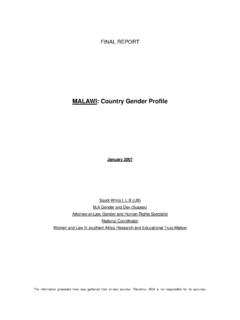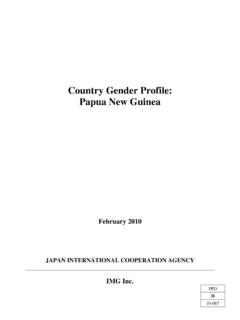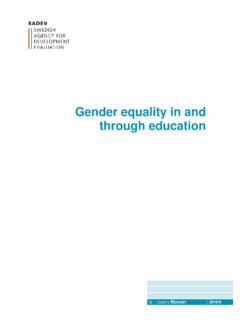Transcription of MODULE 16 GenderIssuesinMonitoringandEvaluation
1 :01-FSB-Ch01 9/22/08 9:39 AM Page 675. MODULE 16. gender Issues in Monitoring and Evaluation Overview C. ommon sense tells us that if we do not consciously What role do different genders play in agriculture, rural attempt to measure our progress in life, we will not development, and water management? Women are the key know whether we have achieved our planned agricultural workers in some countries but are not involved impact in other words, what gets measured, gets man- at all in others. In many southern African countries, women aged. Given the enormous amounts of money invested in provide most of the labor for agriculture and small livestock agricultural and rural development by national govern- production, yet in many cases they receive little benefit.
2 In ments and international donors, monitoring and evaluation Asia different tasks in the agricultural cycle are carried out (M&E) are accepted as important steps for assessing by men or women. In most countries, large livestock such as progress toward specific outcomes and for measuring cattle are managed by men, although milking may be done impact. Although gender and social equity are commonly by women. Roles (and relative power) in production, pro- discussed priorities in agricultural and rural development, cessing, and marketing differ by gender for example, men little progress has been made in measuring outcomes in commonly catch fish and women process or sell them these areas.
3 This MODULE aims to address gender concerns in locally. gender power relations, therefore, lie at the heart of designing agricultural and rural development projects and two critical development concerns: who gains access to to provide ideas for improving the M&E of outcomes and resources, and who benefits from projects? impacts. It addresses the question, How will my agriculture When carrying out M&E, the overarching notion of gen- projects improve if I track and measure gender ? der must be unpacked to reveal the differences within cate- gories of men and women, as neither men nor women form a homogeneous group.
4 Participatory rural appraisal and REASONS WE SHOULD MONITOR gender . gender analysis during planning should provide information gender must be addressed in ongoing monitoring and in on different subgroups of men and women and help design evaluations for the same reasons we address other issues: appropriate activities and indicators. For instance, in an envi- in assessing whether an activity is achieving its objectives, ronmental administration project in Nepal, an assessment of we can consider what has been accomplished and what can gender and poverty issues related to industry was done to be learned and fed back into further efforts.
5 gender is a provide a baseline and better understand the impacts of cross-cutting issue within the development policies of planned activities on different groups (disaggregated by eth- most international donors and national governments. If nicity, caste, education, employment, rural or urban location, gender impacts are not evaluated, they are unlikely to be and other characteristics). M&E should provide feedback on given any attention. how a program's various activities affect different subgroups 675. :01-FSB-Ch01 9/22/08 9:39 AM Page 676. of men and women. Any disparities in the distribution of Monitoring has been defined as the continuous benefits must be known for corrective action to be taken.
6 Assessment of project implementation in relation to agreed Women are active in community decision making in schedules and use of inputs, infrastructure, and services by some countries, through councils and church groups (for project beneficiaries, and evaluation has been defined instance, in the Pacific), whereas elsewhere they are almost as the periodic assessment of the relevance, performance, invisible to outsiders (such as in remote areas of efficiency, and impact (expected and unexpected) of the Afghanistan or Nepal). On the other hand, women may project in relation to stated objectives (World Bank ).
7 Have little time for such activities because of their concur- M&E are broadly viewed as a function of project manage- rent involvement in household activities and their heavy ment that is useful for validating ex ante analysis or for influ- agricultural work. Such commitments only add to the time encing adjustments to project implementation. constraint when planning for M&E and the inclusion of Traditionally many donors used the logical framework women in a given program, project, or activity. Box lists ( logframe ) as the basis for designing M&E. In 2003 the tools for gender -sensitive monitoring, which is discussed at World Bank began using a results framework (a simplified greater length in all of the Thematic Notes.)
8 Logframe) in an effort to focus more on the immediate results of programs and projects. Practitioners now need to link Box A Selection of Methods and performance with outcomes, with rigorous and credible Tools Available for gender - assessments of progress toward (and achievement of). Sensitive Monitoring outcomes. At the Activity level in the results framework, Monitoring can be based on quantitative mea- Output Indicators are used to monitor progress. At the level sures, such as data issued by statistics offices or of Project Development Objective and Components/. specifically collected by project staff.
9 Results, Outcome Indicators are developed. Outcomes . Qualitative monitoring can be done through reflect the quality of outputs produced and behavioral tools such as interviews, observation, and focus changes in target groups, as well as changes in institutional groups. performance following adoption of project outputs. How- Participation of intended beneficiaries in moni- ever, to look at the long-term sustainability of a program, toring is a means to ensure ownership and to the overall development goal should also be considered, and ensure that an activity is truly benefiting the for this purpose the logical framework remains important.
10 Participants. Progress toward higher-level goals can be considered in Participatory monitoring, on the other hand, is a evaluations by developing higher-level Impact Indicators . means of involving stakeholders from the start in such activities as identifying activities and (FAO 2001). This topic is discussed in more detail in indicators that should be monitored, carrying Thematic Note 1. out the monitoring itself, and analyzing the results for improving future processes. INTEGRATING gender IN M&E: LESSONS FROM. External monitoring or evaluation provides EXPERIENCE. independent, external feedback on progress and outcomes.

















